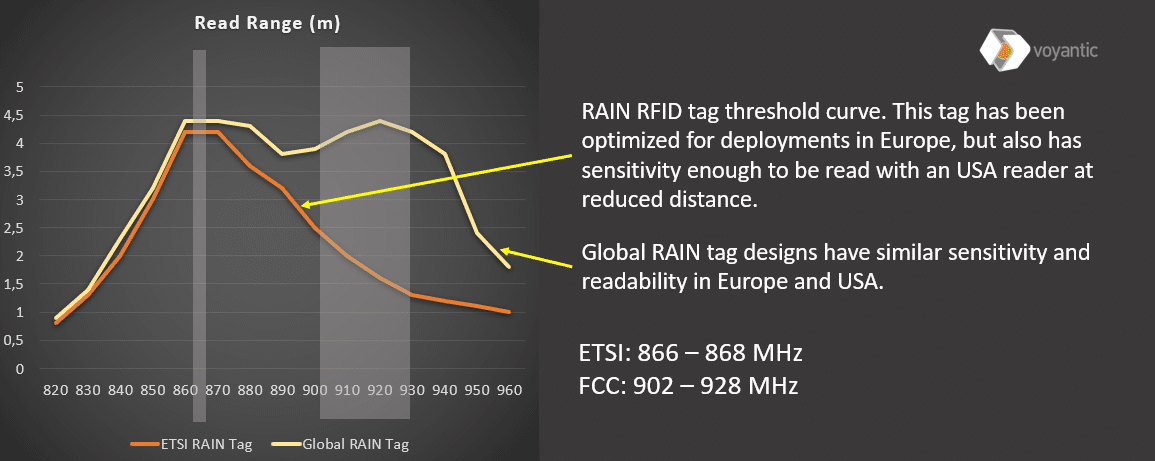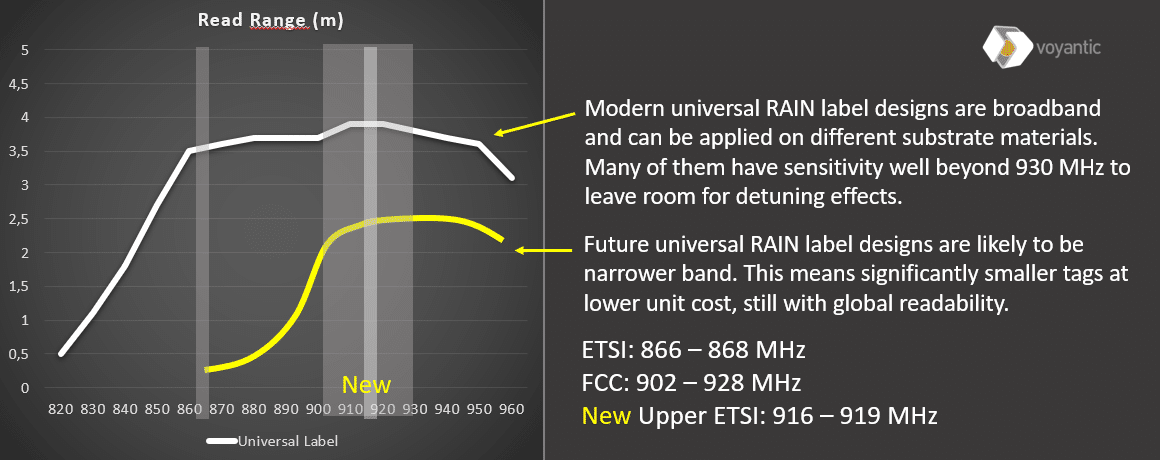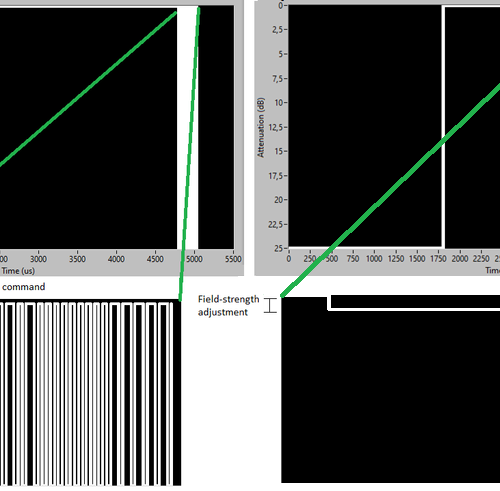In January 2016 I wrote a blog about how RAIN RFID companies should defend their interests especially in Europe. Frequency regulation moves forward slowly, and now 2,5 years later it gives me great pleasure to conclude that the results so far are rather impressive. Let’s have a look at how the upper ETSI band potentially changes the way tagging is optimized. Surely the change is not immediate, and my story further highlights two factors that currently prevent end users from benefiting from this new regulation.
How Tags Are Traditionally Tuned
In 2005 RAIN tagging in Europe was largely optimized for the 866-868 MHz frequency band. Such tagging provided only very limited or non-existent readability in US, which quickly lead to emergence of global tag designs.

While global readability has not been a major technical challenge, it has forced antenna designers to sacrifice some of tag’s sensitivity. On the on-metal tag side global readability leads to significantly larger sized tags compared with the tiny one-band designs, which is both an inconvenience and a price factor.
The European Commission Permits 4W for RFID Readers at 916-919 MHz
Finally, the long-awaited COMMISSION IMPLEMENTING DECISION [EU] 2018/1538 dated 11th October 2018 says that member states should open three channels within the 916,1 -918,9 MHz frequency band for RFID readers by 1st February 2019. This comes on top of the ETSI EN 302 208 V3.1.0 standard which also defines a RFID band between 915 and 921 MHz, although with limited implementation status within the EU and CEPT countries.
While all this sounds like a fantastic outcome after years of technical argumentation and lobbying, a new variety of technical challenges are introduced for reader manufacturers. However, what will be the long term impact of this decision on the RFID tagging side?
Global Sweet Spot for Tagging
As intended, the upper ETSI band introduces a global harmonized frequency band, where all geographic regions have available channels for RFID readers!

Also in Europe this introduces a possibility to optimize tag designs specifically for the upper frequency range. In applications where readers have plenty of time to conduct inventory and scan through all the ETSI frequencies, such limited response from tags sensitive only at the upper ETSI frequencies should not be a problem. Naturally this assumes that in the future the ETSI readers will utilize both the traditional 866-868 MHz and the new upper 916-919 MHz frequency band.
Unknown Factor #1: Implementation Schedule in Middle-Europe
Currently the GSM-R(ailway) is using the 918-921 MHz band in Germany, Austria and France based on National Law in accordance with the ITU Radio Regulations. Unfortunately this band overlaps with the upper ETSI RFID band. The military usage of the same band in Germany is another question mark, and even a roadblock. The Commission recognizes the situation, and gives member states the possibility to coordinate the use of GSM-R and RFID based on geography, specific installation, operating requirements or something else.
What does this mean in practice? I actually do not know. No RFID implementation guidelines are yet published in Germany, Austria or France, but it’s good to keep an eye on the: GS1 regulatory overview for updates. Good news is that the Future Railway Mobile Communication System (FRMCS) should not overlap with RFID anymore. Bad news is that it’s now known when the railways will have such system designed or deployed – the FRMCS project has only been active since 2012… I personally anticipate that implementation schedule in Middle-Europe gains further clarity by second half of 2019.
Unknown Factor #2: Impact of Reader Sensitivity
The read range is often more an opinion than a fact, but the sensitivity of the reader is indeed already a limiting factor in many applications. An example is marathon race timing, and Mr. Nikias Klohr of race result AG has repeatedly raised this issue in his excellent presentations at the RFID Tomorrow and RAIN face-to-face meeting in Vienna 2018.
We all have seen over the past 15 years how the increased tag IC sensitivity has translated into smaller footprint tags rather than to ultra long >20 meter read ranges. If my prediction of tag design optimization for the 902-928 MHz band is correct, then the tag footprint will further shrink with the benefit of lower tagging costs.
By year 2021 backscatter signal strengths from miniature RAIN tags may fall below -90 dBm, even down to -100 dBm. The current reader infrastructure simply won’t be able to interpret such small tag responses, therefore larger-than-necessary tags may still need to be used at a higher expense. Therefore a new breed of readers and infrastructure with enhanced reading capabilities will be needed to continue drive down the overall cost of RAIN RFID technology.
Work Continues
What is your view on the significance of the upper ETSI band? Do you have insights into the local regulatory debates in Germany or France? Please contact us and let’s talk!
All blog posts

